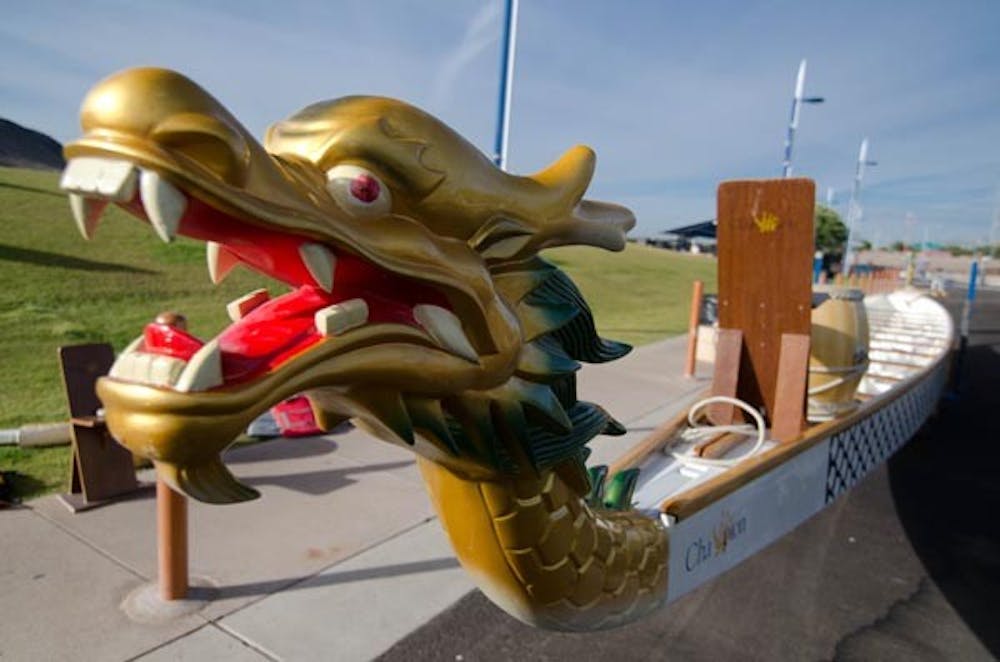Long, narrow vessels and their passengers glided across Tempe Town Lake Saturday, creating light waves in their wake.
The Arizona Dragon Boat Association, which has a registered ASU team, was joined by Na Leo 'O Ke Kai, an outrigger canoe club, to recruit new members.
Coaches and current members from the clubs were on hand to take interested community members out on the lake so they could try paddling for themselves.
The clubs usually hold their open house event in October, but it was rescheduled because the lake was not ready to reopen, said Louis Benabe, event organizer with the dragon boat community.
Chemistry freshman Nick Linville is a member of both the ASU dragon boat team and the Arizona Dragon Riders, a club based out of Tempe.
He said he has been a dragon boat paddler since high school.
“It took the place of basketball for me,” Linville said.
He joined multiple clubs because he wanted to have a better workout and he found it stress relieving.
About 12 curious community members joined more experienced club members like Linville, hopping on board 42-foot-long and 600-pound dragon boats to try out paddling for the first time, Benabe said.
“It’s unique to people to practice in a town lake in a landlocked state,” he said.
The boats seat a 20-person crew and are part of a tradition that originated many centuries ago in China.
Dragon boating came to Tempe eight years ago and there are nine teams across Arizona, including teams from ASU and Maricopa Community College, he said.
The paddlers compete in 500-meter races, and teams with members from the Special Olympics participate in 250-meter races. About 95 paddlers are registered with the Arizona Dragon Boat Association, although not all of them compete, he said.
The annual SRP Dragon Boat festival takes place in March, and last year the event drew 65 clubs from across the Western U.S. Many people get involved in dragon boating through corporate teams put together specifically for this event.
The outrigger canoe club was also introducing new paddlers to their sport. These canoes are 45 feet in length but are much lighter and narrower than a dragon boat and only seat six paddlers.
The boats have a floatation device called an alma along the left side of the boat, which is set away from the hull to keep it from capsizing.
Louise Navano, an original founder of the club, said it was established in 1997 as the first outrigger canoe club in Arizona. The Hawaiian name of the club, Na Leo ‘O Ke Kai, means “the voice of the sea.”
“You have the voice of the sea in the middle of the desert,” Navano said.
Outrigger canoes originated in Polynesia and Hawaii as transportation between the islands. The Hawaiian culture is still embedded as part of the sport, as evidenced by the freshly twisted green ti leaf bracelets made on site for the occasion.
The sport is also gaining in notoriety internationally. For the first time, it will be an exhibition sport in the 2012 London Olympics.
Head coach Margaret Coulombe, a science writer for the School of Life Sciences at ASU, said she started the club in 2005.
Outrigger canoe teams compete in races that range in length from 500 meters to relay races as long as 40 miles, Coulombe said.
The long-distance races are called change races. During these races, fresh team members replace three people in the boat every 20 minutes. There are about 10 to 12 replacements. The members of the team follow the canoe in an escort boat and then swim out to the canoe to relieve their teammates.
The team did well this season, she said. They were able to practice at other lakes in the area while Tempe Town Lake was dry.
They won first place in the 12-mile Round the Rock Alcatraz Challenge race in the San Francisco Bay, and for the first time, took part in the Na Pali Challenge in Kawai, a 38-mile “change race,” she said.
Some of the people in the club started as children in Hawaii, but others heard about it through word-of-mouth.
Manoush Farzin, a biology lab coordinator at ASU, has been paddling with the club for about two years and she said she really enjoys the workout and the culture of the club.
“I just love the people. It’s like a huge family and that’s hard to find.” Farzin said.
Coulombe said this year the club is going to start a Keiki team, or children’s team, and she would also like to start a college team.
Reach the reporter at mary.shinn@asu.edu





